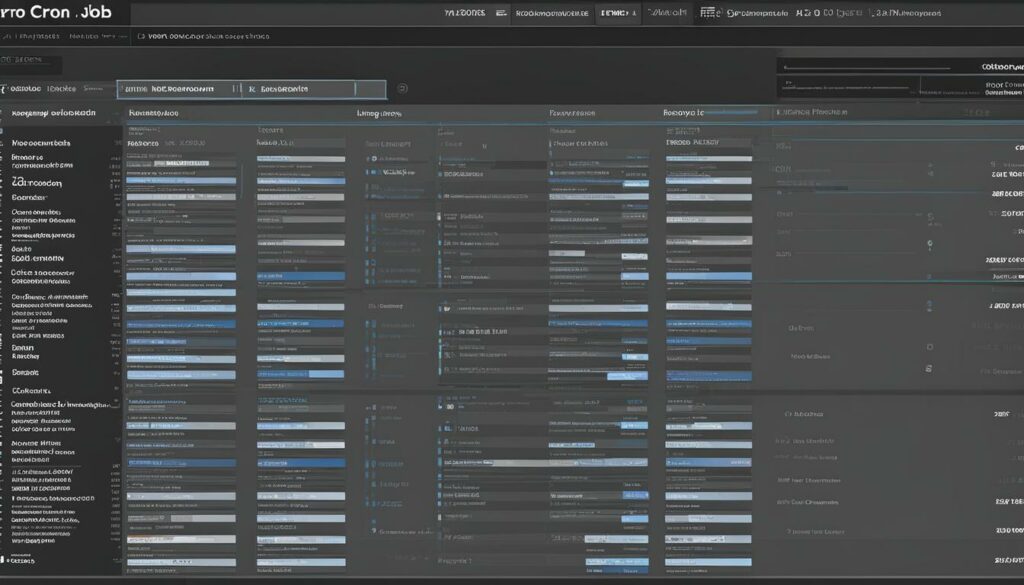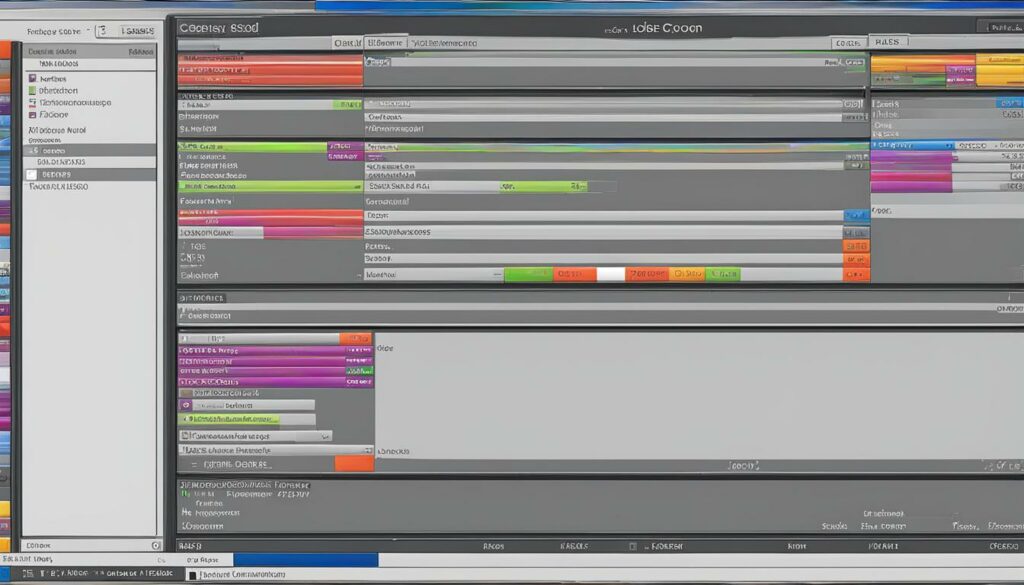Tired of repeating the same tasks every day? Cron jobs offer a solution to automate routine tasks on Linux systems. Cron is a scheduler that allows you to set up a timetable for your computer to perform certain jobs automatically. By defining a schedule, you can automate tasks such as backups, file cleanups, and routine maintenance. With cron jobs, you can save time and increase efficiency by letting the computer handle repetitive chores while you focus on more important tasks.
We recommend WordPress Hosting from BoostedHost for optimal performance. Sign up now through this link.
Key Takeaways
- Navigating CRON Jobs
- CRON job management
- CRON scheduling
- CRON expressions
- CRON job syntax
What is Cron?
Cron is a versatile system utility in Linux that serves as a powerful scheduler, allowing you to automate tasks effortlessly. By leveraging cron, you can set up a timetable to execute specific jobs at predetermined times or intervals, relieving yourself of the burden of manual execution.
With cron, you have the ability to automate a variety of tasks, including backups, file cleanups, and routine maintenance. By defining a schedule using cron job syntax, you can ensure that these tasks are performed reliably and efficiently, allowing you to focus on more important aspects of your work.
Cron acts as a reliable scheduler, taking care of repetitive tasks on your behalf, making your computer work for you. By setting up cron jobs, you can navigate through the world of task automation, saving time and increasing productivity.
“Cron is like having a personal assistant for your computer. It takes care of routine tasks so you can focus on the things that truly matter.”
Navigating CRON Jobs: Streamlining Tasks with Ease
When using cron, you can take advantage of its flexibility and efficiency while setting up a range of automated tasks. The following are just a few examples of the tasks you can automate with cron:
- Scheduling regular backups of important files and database
- Automatically cleaning up temporary files and redundant data
- Performing routine maintenance tasks, such as updating software or restarting servers
By automating these tasks, you can ensure that your system runs smoothly and efficiently, without the need for manual intervention.
Cron Job Syntax: Making Task Scheduling a Breeze
Understanding the syntax of cron jobs is essential for setting up effective schedules. Cron job entries consist of predefined fields representing specific time units, such as minutes, hours, days of the month, months, and days of the week. By manipulating these fields, you can create custom schedules that suit your needs.
To help you get started, here’s a basic breakdown of the syntax:
| Field | Description | Values |
|---|---|---|
| Minutes | Minute of the hour | 0-59 |
| Hours | Hour of the day | 0-23 |
| Day of the month | Day of the month | 1-31 |
| Month | Month of the year | 1-12 |
| Day of the week | Day of the week | 0-7 (both 0 and 7 represent Sunday) |
The syntax allows for flexible scheduling options, enabling you to set up tasks that run daily, weekly, monthly, or at specific times and dates.
To make the most of cron jobs and harness their full potential, it’s important to familiarize yourself with the available options and experiment with different schedules to find what works best for your specific needs.
Automating tasks using cron not only helps streamline your workflow but also improves productivity. By taking advantage of the scheduling capabilities of cron, you can ensure that routine tasks are carried out promptly and efficiently, freeing up valuable time for more critical responsibilities.
Next, let’s explore crontab, a command-line utility that allows you to create, manage, and edit your cron job schedules with ease.
What is Crontab?
In order to efficiently manage your cron schedules, you can utilize a command-line utility known as crontab. Crontab allows you to easily create, edit, and manage schedules for your cron jobs. Each user has their own user-specific crontab file, where they can define the schedule for their tasks. By utilizing crontab, you have the flexibility to create and manage schedules according to your specific needs.
With crontab, you have the power to navigate your cron jobs with ease. Whether you need to create new schedules, edit existing ones, or simply manage your schedules, crontab has got you covered. By providing a user-friendly interface, you can conveniently set up the timing and frequency of your tasks, ensuring that they run smoothly and efficiently.
One of the key benefits of using crontab is its command-line interface, which allows for seamless interaction with the scheduler. By accessing the crontab file through the command line, you have complete control over your schedules, enabling you to make changes and adjustments as needed.
Additionally, the user-specific crontab file ensures that each user’s schedules are independent and distinct. This means that you can create and manage your own set of schedules without interfering with others. The cron daemon, responsible for executing scheduled tasks, reads these user-specific crontab files to determine when to trigger the tasks.
Crontab provides a convenient and efficient way for you to navigate and manage your cron jobs. By leveraging the power of this command-line utility, you can confidently create, edit, and manage schedules for your tasks, ensuring that they are executed at the right time and frequency.

| Benefits of Crontab | Features |
|---|---|
| Easy creation of schedules | User-specific crontab file |
| Efficient editing and management of schedules | Cron daemon integration |
| Complete control through the command-line interface | Flexibility in scheduling tasks |
| Independent schedules for each user | Reliable execution of tasks |
Starting with Crontab File
To start using cron jobs, you need to work with the crontab file. The process may differ depending on whether you’re running cron jobs with the root user or any other user. In the case of using the root user, you’ll need to use the Ubuntu Command Prompt as the administrator. By using the command sudo su and entering the system password, you’ll gain admin privileges.
To ensure that you’re working with the correct version of Ubuntu OS, you can use the command lsb_release -a to check the version information.
Next, you’ll want to verify the existence of the crontab module. This can be done with the cat /etc/crontab command, which will read the crontab file and display its output. This allows you to check if the crontab module is present and functioning correctly.
Finally, you may want to check the folder location of the crontab module. This can be done using the which command, which will display the path to the crontab module folder. Verifying the module’s location ensures that it is in the correct directory for managing cron jobs.
By following these steps, you can ensure that the crontab module is present, functioning properly, and in the correct location for managing cron jobs.
| Command | Description |
|---|---|
sudo su |
Gain admin privileges as the root user in the Ubuntu Command Prompt |
lsb_release -a |
Check the version information of the Ubuntu OS |
cat /etc/crontab |
Read and display the contents of the crontab file |
which crontab |
Display the folder location of the crontab module |
Crontab Initialization
Once you have set up your crontab file, the next step is to initialize the crontab service. This involves checking if the crontab service is running and starting it if necessary.
To check if cron is running, use the command service cron status. This command will provide you with the current status of the cron service. If the output shows that “cron is not running,” you will need to start the service.
To start the cron service, simply use the command service cron start. This will initiate the cron service and ensure that your scheduled cron jobs are executed as intended.
By following these steps, you can ensure that your cron service is initialized and running, preventing any scheduling errors and ensuring the successful execution of your cron jobs.

How to List All the Cron jobs for the Current User
To manage your cron jobs effectively, it is essential to be able to view and list all the tasks scheduled for the current user. By using the crontab -l command, you can easily obtain an overview of your existing cron jobs.
To list all the cron jobs for the current user, follow these steps:
- Open your terminal or command prompt.
- Enter the command
crontab -land press enter. - The output will display all the scheduled jobs associated with the current user.
Listing your cron jobs allows you to have a comprehensive view of the tasks that are set to run automatically at specific times or intervals. This makes it easier to manage and make any necessary adjustments to your cron jobs as needed.
Here’s an example of how the output of the crontab -l command might appear:
0 1 * * * /path/to/script.sh
30 5 * * 1-5 /path/to/backup.sh
*/15 * * * * /path/to/cleanup.sh
In the example above, three cron jobs are listed. The first job runs the script.sh file every day at 1:00 AM. The second job runs the backup.sh file every day at 5:30 AM from Monday to Friday. The third job executes the cleanup.sh script every 15 minutes. This way, you can easily identify the schedule and commands associated with each cron job.
By listing all your cron jobs, you can have a better understanding of your automated tasks and effectively manage your job scheduling.

Cron job Schedule
| Minute | Hour | Day of the Month | Month | Day of the Week | Command |
|---|---|---|---|---|---|
| 0 | 1 | * | * | * | /path/to/script.sh |
| 30 | 5 | * | * | 1-5 | /path/to/backup.sh |
| * | * | * | * | * | /path/to/cleanup.sh |
Here is a visual representation of the cron job schedule:
- The first job runs the
/path/to/script.shfile at 1:00 AM every day. - The second job runs the
/path/to/backup.shfile at 5:30 AM from Monday to Friday. - The third job executes the
/path/to/cleanup.shscript every 15 minutes.
How to Create New Schedules Using Crontab
Creating new schedules using crontab is a straightforward process that allows you to define your own cron jobs according to your specific requirements. To get started, you’ll need to use the crontab editor, which provides a user-friendly interface for managing your cron schedules.
To open the crontab editor, simply use the “crontab -e” command in your Linux terminal. This command will launch the editor and allow you to define your schedules using the crontab syntax.
When working with the crontab editor, you’ll need to understand the syntax for specifying the minute, hour, day of the month, month, and day of the week for your tasks. This syntax follows a specific format that allows you to define precise schedules for your cron jobs.
For example, if you wanted to schedule a backup job to run every day at 2:00 AM, you would use the following syntax:
0 2 * * * /path/to/backup-script.sh
In this example, “0” represents the minute (always zero in this case), “2” represents the hour (2 AM), followed by the day of the month, month, and day of the week, all set to “*”, which means any value.
Once you’ve defined your schedule, you can save and exit the crontab editor. A confirmation message will indicate that your schedule has been successfully added to the crontab file.
By utilizing the crontab editor, you can easily create and manage your cron schedules, automating routine tasks and improving your overall productivity.

Creating new schedules using crontab is a convenient way to automate tasks and streamline your workflow. Whether you’re scheduling backups, running scripts, or performing other routine tasks, the crontab editor provides a user-friendly interface for defining your schedules and ensuring they are executed at the desired times.
To learn more about navigating and managing CRON jobs, check out the next section.
Cron job Syntax
In managing crontab entries, you have various flags at your disposal to add, view, and edit cron jobs. Let’s explore these flags:
crontab -e
Use this flag to edit your crontab entries. It opens the crontab editor, allowing you to add, delete, or modify cron jobs according to your needs. This flag is ideal for managing and fine-tuning your scheduled tasks.
crontab -l
With this flag, you can list all the cron jobs associated with your current user. It provides a convenient overview of your scheduled tasks, allowing you to keep track of what jobs are set to run and when.
crontab -u <username> -l
By using this flag, you can list the cron jobs belonging to another user. It provides access to their scheduled tasks, enabling you to gather information and assist them if needed.
crontab -u <username> -e
When you want to edit cron jobs for another user, this flag comes in handy. It grants you the ability to modify or add cron jobs for the specified username, ensuring seamless job management.
By utilizing these flags, you can efficiently navigate and manage your cron jobs, making sure they are configured correctly and executed as intended.
Cron job examples
When it comes to scheduling cron jobs, the possibilities are endless. Here are some practical examples to help you navigate CRON jobs and automate tasks according to your specific needs:
-
Run a job every day at a specific time:
0 8 * * * /path/to/command -
Run a task at a specific time on specific days:
0 12 * 7 MON,THU /path/to/command -
Execute a script every minute:
* * * * * /path/to/script.sh -
Schedule tasks on specific dates:
0 0 1-15 * * /path/to/command -
Run a task on the first Monday of every month:
0 9 * * 1 [ "$(date '+\%u')" == "1" ] && /path/to/command
These examples demonstrate the versatility and flexibility of cron jobs, allowing you to automate a wide range of tasks. From scheduling backups to monitoring tasks and executing scripts, CRON jobs enable you to save time and streamline your workflow.
Note: Remember to pay attention to the syntax breakdown and specific time intervals when creating your own cron job schedules.
BoostedHost offers reliable WordPress Hosting packages to ensure optimal performance for your cron jobs. Sign up now through this link to boost your website’s efficiency!
Conclusion
Automating tasks with cron jobs is a game-changer when it comes to improving productivity and streamlining your workflow. By harnessing the power of automation and understanding the syntax and commands of cron jobs, you can easily schedule and manage your tasks with precision.
But it doesn’t stop there. To truly optimize your cron job experience, it’s crucial to implement best practices. Testing scripts before deploying them, setting proper permissions for added security, and leveraging special strings to enhance functionality are just a few ways to level up your cron job game.
With the ability to automate tasks and schedule them for specific times or intervals, cron jobs are an invaluable tool for system administrators, developers, and anyone looking to save time and boost efficiency. So, dive in, explore the world of cron expressions, and navigate CRON jobs like a pro. Your productivity will thank you.
FAQ
Q: What is a cron job?
A: A cron job is a scheduler in Linux that allows users to automate tasks by setting up a schedule for their computer to perform certain jobs automatically. It can be used to automate tasks such as backups, file cleanups, and routine maintenance.
Q: What is crontab?
A: Crontab is a command-line utility used to create, edit, and manage cron schedules. It allows users to define the schedule for their cron jobs in a user-specific crontab file.
Q: How do I start using cron jobs?
A: To start using cron jobs, you need to work with the crontab file. The process may differ depending on whether you are using the root user or any other user. You can use the Ubuntu Command Prompt as the administrator and use the “sudo su” command to gain admin privileges.
Q: How do I initialize the crontab service?
A: To initialize the crontab service, you need to check if it is running and start it if necessary. You can use the “service cron status” command to check if cron is running, and if it shows “cron is not running,” you can start the service with the “service cron start” command.
Q: How do I list all the cron jobs for the current user?
A: To list all the cron jobs for the current user, you can use the “crontab -l” command. This command provides an overview of the scheduled tasks associated with the current user.
Q: How do I create new schedules using crontab?
A: To create new schedules using crontab, you can use the crontab editor. Open the crontab editor with the “crontab -e” command, define your schedule according to your requirements using the specified syntax, and save and exit the editor to add the schedule.
Q: What syntax is used for cron jobs?
A: Cron jobs use a specific syntax to define schedules. Users can specify the minute, hour, day of the month, month, and day of the week for their tasks. The syntax varies depending on the specific requirements of the schedule.
Q: Can you provide examples of scheduling cron jobs?
A: Some examples of scheduling cron jobs include running a job every day at a specific time, running a task at a specific time on specific days, executing a script every minute, scheduling tasks on specific dates, and running a task on the first Monday of every month. These examples demonstrate the versatility of cron jobs.
Q: What are some best practices for managing cron jobs?
A: Some best practices for managing cron jobs include testing scripts before scheduling them, setting proper permissions for the cron job files, and using special strings like “@reboot” to execute tasks when the system starts up. These practices can enhance the effectiveness of cron jobs.
Q: How can cron jobs improve efficiency and productivity?
A: Cron jobs automate routine tasks, saving time and allowing users to focus on more important tasks. By scheduling tasks such as backups, file cleanups, and routine maintenance, cron jobs can increase efficiency and productivity by eliminating the need for manual execution of these tasks.












